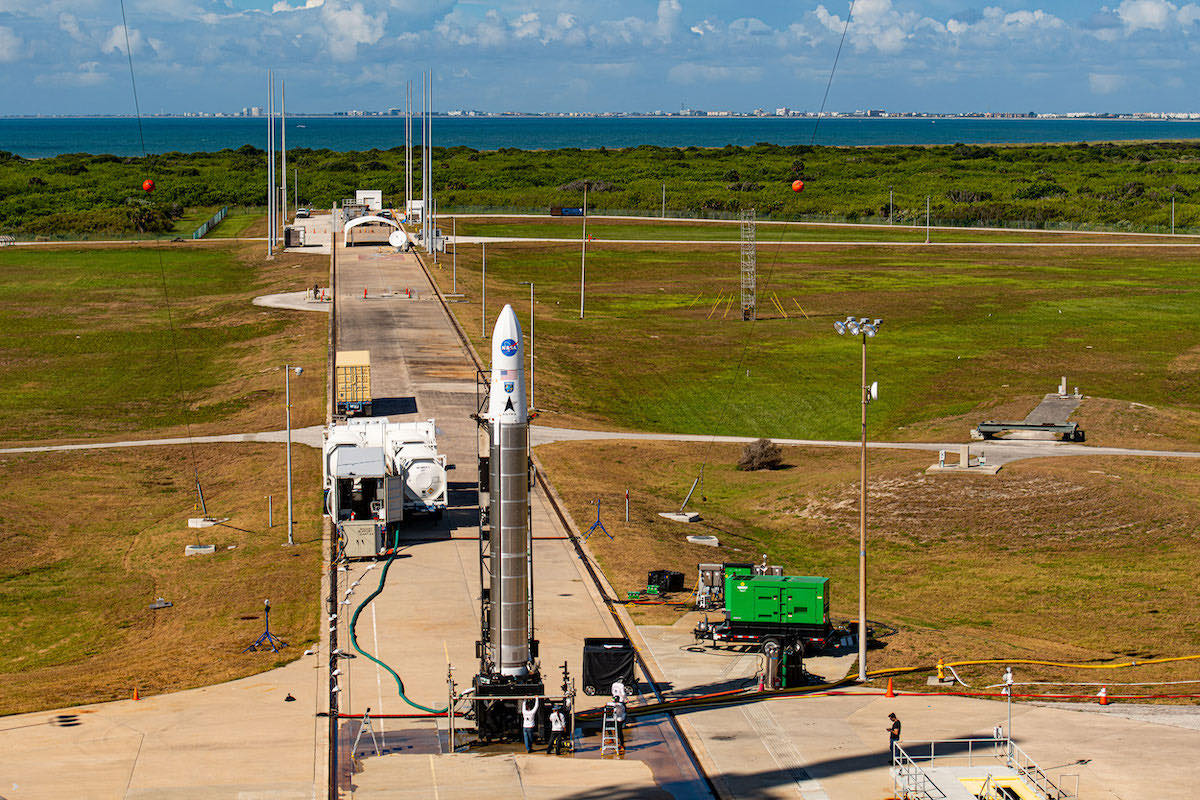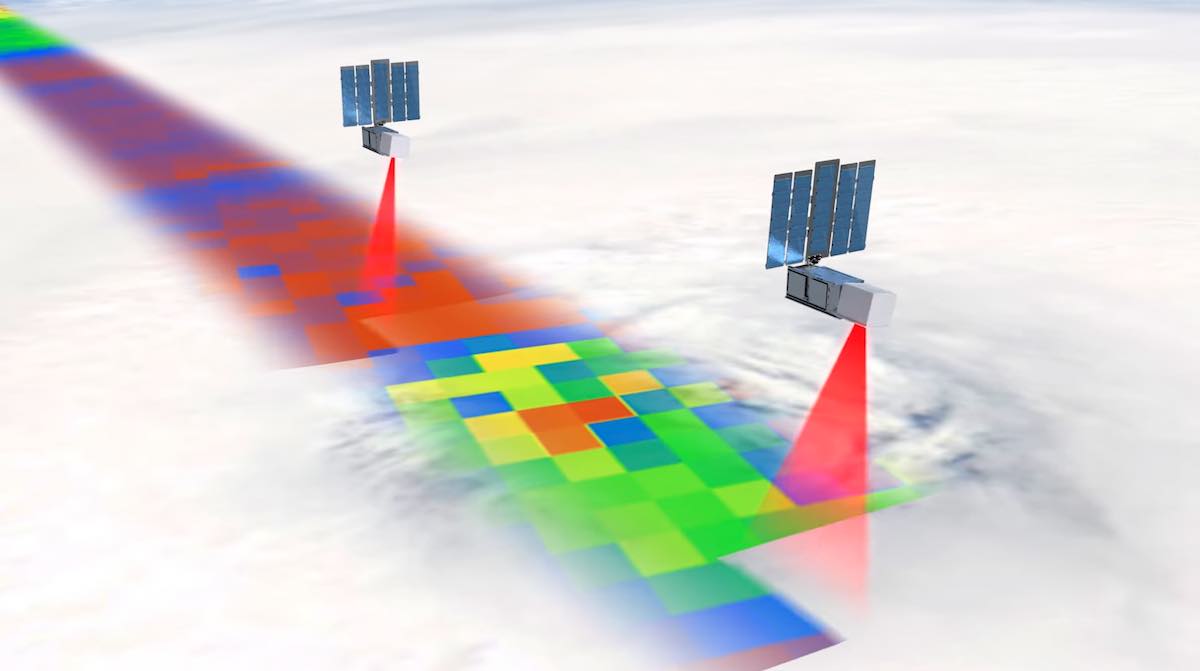Astra is counting down to the first of three launches this summer to deploy a fleet of six small NASA hurricane research satellites. Liftoff of Astra’s small launcher from Cape Canaveral with the first two TROPICS nanosatellites is scheduled during a two-hour window opening at 12 p.m. EDT (1600 GMT), weather permitting.
The official launch weather forecast from the U.S. Space Force’s 45th Weather Squadron predicts a 60% chance of unfavorable conditions for liftoff at the opening of the two-hour window Sunday. By the end of the window, the probability of bad weather rises to 90%.
Astra will launch the mission from Space Launch Complex 46, a commercial launch facility operated by Space Florida near the eastern tip of Cape Canaveral Space Force Station.
The rocket flying Sunday, called Rocket 3.3 or LV0010, is the smallest orbital-class launcher currently in service worldwide. It stands about 43 feet (13.1 meters) tall and weighs about as much as a small business jet when fully fueled.
The two TROPICS satellites are each about the size of a loaf of bread or a shoebox. They are crammed with miniaturized sensor technology that once needed to fly on a satellite larger than a refrigerator.
Microwave radiometers on each of the TROPICS satellites will collect imagery, temperature and moisture data over tropical cyclones. With a fleet of satellites, the TROPICS mission will be capable of monitoring rapid changes in cyclones at a cadence of at least once per hour.
“Those are important variables because they can be related to the intensity of the storm, and even potential for future intensification,” said William Blackwell, principal investigator for the TROPICS mission from MIT Lincoln Laboratory. “So we’re trying to make those measurements with relatively high revisit. That’s really the key new feature that the TROPICS constellation provides, is improved revisit of the storms.
“We’ll have six satellites orbiting, and one satellite will work to make a nice image of the storm, and then the next satellite will orbit closely behind it about an hour behind,” Blackwell said. “So we’ll get, roughly every hour, a new image of the storm, and that’s about a factor of five-to-eight better than what we get today. With these new measurements of rapidly updated imagery, we hope that that will help us understand the storm better, and ultimately lead to better forecasting of the hurricane track and intensity.”
TROPICS stands for Time-Resolved Observations of Precipitation structure and storm Intensity with a Constellation of Smallsats. The mission has a total cost of approximately $32 million, according to NASA.
Each TROPICS satellite, assembled by Blue Canyon Technologies in Colorado, weighs about 11.8 pounds (5.3 kilograms).
Astra will aim to release the two TROPICS satellites into an orbit about 357 miles (550 kilometers) above Earth, with an inclination of 29.75 degrees to the equator. The low-inclination orbit will focus the TROPICS observations on hotspots for tropical cyclone development.

Founded in 2016, Astra aims to eventually launch daily missions to carry small satellites into orbit for a range of customers, including the U.S. military, commercial companies, and NASA. The company has successfully reached orbit in two of six tries.
Astra’s most recent flight in March marked the first time the company placed functioning satellites into orbit, following a liftoff from Kodiak Island, Alaska. The previous Astra launch in February, which departed Cape Canaveral, failed to place a payload of NASA-sponsored CubeSats into orbit.
NASA officials are aware of the risk of flying satellites on a new, relatively unproven launcher. TROPICS is part of NASA’s Earth Venture program, a series of cost-capped missions designed for Earth science research. NASA assumes more risk for Venture-class missions, and the agency says only four of the six TROPICS satellites, or two of the three Astra launches, need to work.
Astra’s first launch with two TROPICS satellites will begin with the ignition of Rocket 3.3’s five kerosene-fueled engines at pad 46. The Delphin engines will drive the launcher off the pad with 32,500 pounds of thrust, powering the rocket downrange to the east-northeast from Cape Canaveral.
First stage engine cutoff is expected three minutes after liftoff, followed by separation of the rocket’s payload shroud, which covers the upper stage and the TROPICS payloads during the climb through the atmosphere. Then rocket’s booster stage will jettison to fall into the Atlantic, allowing the upper stage to ignite its small 740-pound-thrust for a five-minute burn to accelerate to orbital velocity.
Deployment the TROPICS satellites is scheduled at T+plus 8 minutes, 40 seconds, according to a mission timeline posted by Astra.
The satellites will unfurl solar panels to begin generating electricity, and ground teams will run the TROPICS spacecraft through tests and checkouts.

The second and third TROPICS launches — currently planned for late June and mid-July — will aim to deploy the next four satellites into precise orbital planes, giving the constellation the proper spacing to enable regular flyovers of cyclones.
If the three TROPICS launches get off the ground as scheduled, the satellites should all be collecting by August, just in time for the peak of the Atlantic hurricane season, according to Will McCarty, NASA’s program scientist for the mission. The mission is designed for at least one year of science observations.
Many CubeSats ride to space on rideshare launches, allowing operators to take advantage of lower costs by bundling their payloads on a single large rocket. But the TROPICS satellites need dedicated launches to reach their precise orbital destinations.
“We want to space out the spacecraft as much as we can, and want to keep them over the tropical cyclone belt,” Blackwell said. “This overall configuration lets us do that, but it requires three separate dedicated launchers.”
Astra beat out bids from SpaceX, Rocket Lab, Virgin Orbit, and Momentus, largely due to their lower-cost proposal, according to NASA. NASA is paying Astra nearly $8 million for the entire three-launch campaign.
ROCKET: Astra’s Rocket 3.3 (LV0010)
PAYLOAD: TROPICS-1 (two satellites)
LAUNCH SITE: SLC-46, Cape Canaveral Space Force Station, Florida
LAUNCH DATE: June 12, 2022
LAUNCH WINDOW: 12:00-2:00 p.m. EDT (1600-1800 GMT)
WEATHER FORECAST: 60% to 90% chance of violating weather constraints
BOOSTER RECOVERY: None
LAUNCH AZIMUTH: East-northeast
TARGET ORBIT: 357 miles (550 kilometers), 29.75 degrees inclination
LAUNCH TIMELINE:
- T+00:00: Liftoff
- T+00:06: Begin pitch over
- T+01:10: Maximum aerodynamic pressure (Max-Q)
- T+03:00: First stage main engine cutoff (MECO)
- T+03:05: Payload fairing jettison
- T+03:10: Stage separation
- T+03:15: Second stage engine ignition
- T+08:30: Second stage engine cutoff (SECO)
- T+08:40: TROPICS deployment
MISSION STATS:
- 7th orbital launch attempt by Astra
- 5th launch of Astra’s Rocket 3.3 configuration
- 2nd Astra launch from Florida
- 5th orbital launch attempt from pad 46
- 3rd Astra launch of 2022
- 24th orbital launch based out of Cape Canaveral in 2022
Email the author.
Follow Stephen Clark on Twitter: @StephenClark1.